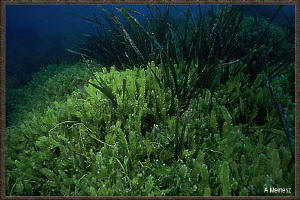|
Invasive Algae Home Red Algae Green Algae Brown Algae Seagrasses Glossary |
|
|
|||||||||
|
|||||||||
|
|
|||||||||
|
|||||||||
|
Click on pictures for larger image.
Caulerpa taxifolia has gained worldwide attention and the nickname "killer algae" because of its great success in coastal Mediterranean waters. It is a native species in Hawaii where it has not exhibited invasive tendencies.
The invasive Caulerpa taxifolia in the Mediterrnean. |
|
||||||||
|
Description Branches, feather-like, flattened, and upright, 3 - 10 cm high, rising from a creeping stolon (runner), 1 - 2 mm in diameter, anchored by rhizoids to the substrate. Branchlets oppositely attached to midrib, flattened, slightly curved upwards, tapered at both base and tip, and constricted at point of attachment. Midrib is slightly flattened, appearing oval in cross-section. Dark green to light green.
This species resembles another Hawaiian Caulerpa species, C. sertularioides. C. sertularioides is more delicate and the branchlets are rounded, compared to the flattened branchlets of C. taxifolia. The rising branches are also more rounded toward apices, compared to the more angular, squared-off branches of C. taxifolia.
Structural Features Thallus non-septate, coenocytic, traversed by trabeculae, which are extensions of cell wall; reproduction vegetative and sexual, latter anisogamous. Gametes liberated through papillae that develop on frond or occasionally on frond.
Habitat In Hawaii, small patches grow in sandy areas of tidepools and reef flats. In its maximum invasive state, it can cover all favorable available substrates, including rock, sand, and mud.
Distribution Hawai‘i: Kaua‘i, Lana‘i, Moloka‘i, O‘ahu, and Hawai‘i Island.Mechanism of Introduction: Indigenous to Hawai‘i. Worldwide: Australia, California, Mediterranean, Eastern Atlantic (Africa, Canaries), Western Atlantic, Indo-Pacific, Caribbean, Gulf of Mexico.
Ecology/Impact Caulerpa taxifolia is a native alga of Hawai‘i, where it has not demonstrated any invasive tendencies. However, this common green alga has gained wide notoriety from its large outbreaks after accidental introduction in the Mediterranean and California. Due to the Mediterranean strain’s high growth rate, toxicity to predators and longevity, C. taxifolia has proven to be very successful in many non-native habitats. In areas of massive invasion, this alga’s spread is associated primarily with human factors. Natural dispersion occurs near the central invasion zone, but more widespread dissemination by humans is facilitated by transport in the anchoring systems of pleasure boats and by fishing nets.
C. taxifolia has a number of characteristics that make it a successful invader. An extensive rhizoid system aids in nutrient acquisition from sediments in nutrient-poor waters. Also, although it also reproduces sexually, settlement takes place primarily by fragmentation increasing the rate of dispersion. And part of this species success as an invader in non-native habitats is the lack of natural predators. Predation by herbivorous fish and invertebrates is an important controlling factor in the ecology of this alga. C. taxifolia grows unchecked in environments with no natural predators, such as the Mediterranean Sea. One possible form of control is the introduction of a natural predator into the invaded environment. However, introducing additional species can add more problems to an already stressed ecosystem. There is a major decrease in all marine species and a decline in fish biomass in areas where C. taxifolia has become a serious problem.
Quarantines The Mediterranean clone or strain of Caulerpa taxifolia has been designated a U.S. Federal Noxious Weed and currently prohibited in the U.S. This alga continues to be found in the aquarium trade. California is considering legislation that would ban importation of all Caulerpa species.
|
|||||||||
|
|
|
|
References Abbott, I.A., 2001, unpublished manuscript. Eubank, L.L., 1946. Hawaiian Representatives of the Genus Caulerpa. University of California Publications in Botany, V. 18: 409-432. Jousson, O., J. Pawlowski, L. Zaninetti, F.W. Zechman, F. Dini, G. Di Guiseppe, R. Woodfield, A. Millar, A. Meinesz, 2000. Invasive alga reaches California. Nature, Nov. 408:157. Littler, D.S. and Mark M., 2000. Caribbean Reef Plants. OffShore Graphics, Washington, D.C. Magruder, W.H., and J.W. Hunt, 1979. Seaweeds of Hawai‘i. Oriental Publ. Co., Honolulu, Hawai‘i. Meinesz, A., J. deVaugelas, B. Hesse & X. Mari, 1993. Spread of the introduced tropical green alga Caulerpa taxifolia in northern Meditierranean waters. Journal of Applied Phycology 5: 141-147. |
Web Pages Essay about Caulerpa taxifolia: http://www.sbg.ac.at/ipk/avstudio/pierofun/ct/caulerpa.htm ECOism: Caulerpa taxifolia simulation. http://www.isima.fr/ecosim/ct.html Killer Algae Found in Southern California Waters (Woodfield article): http://nas.er.usgs.gov/algae/caulerpa.htm |

